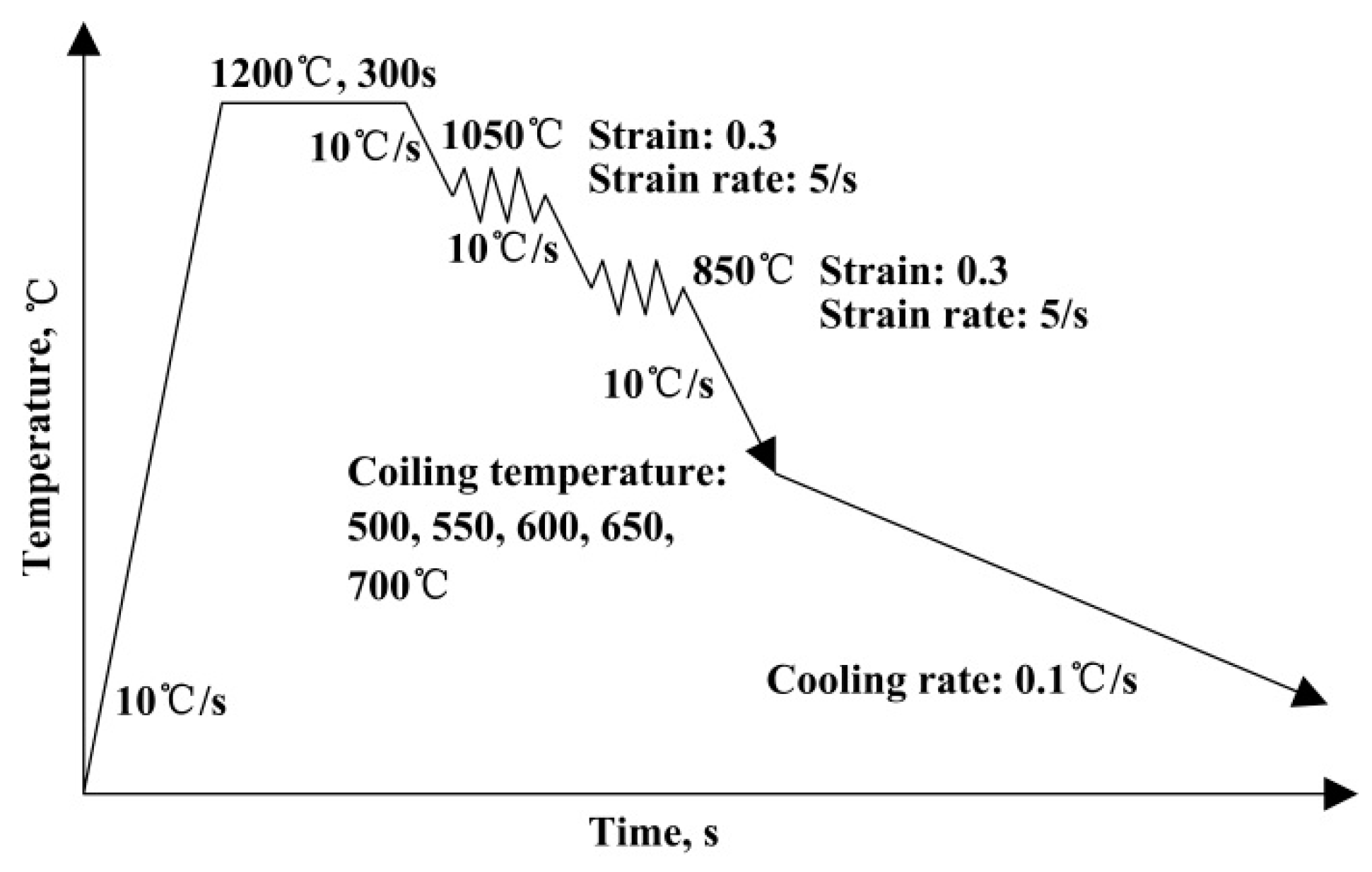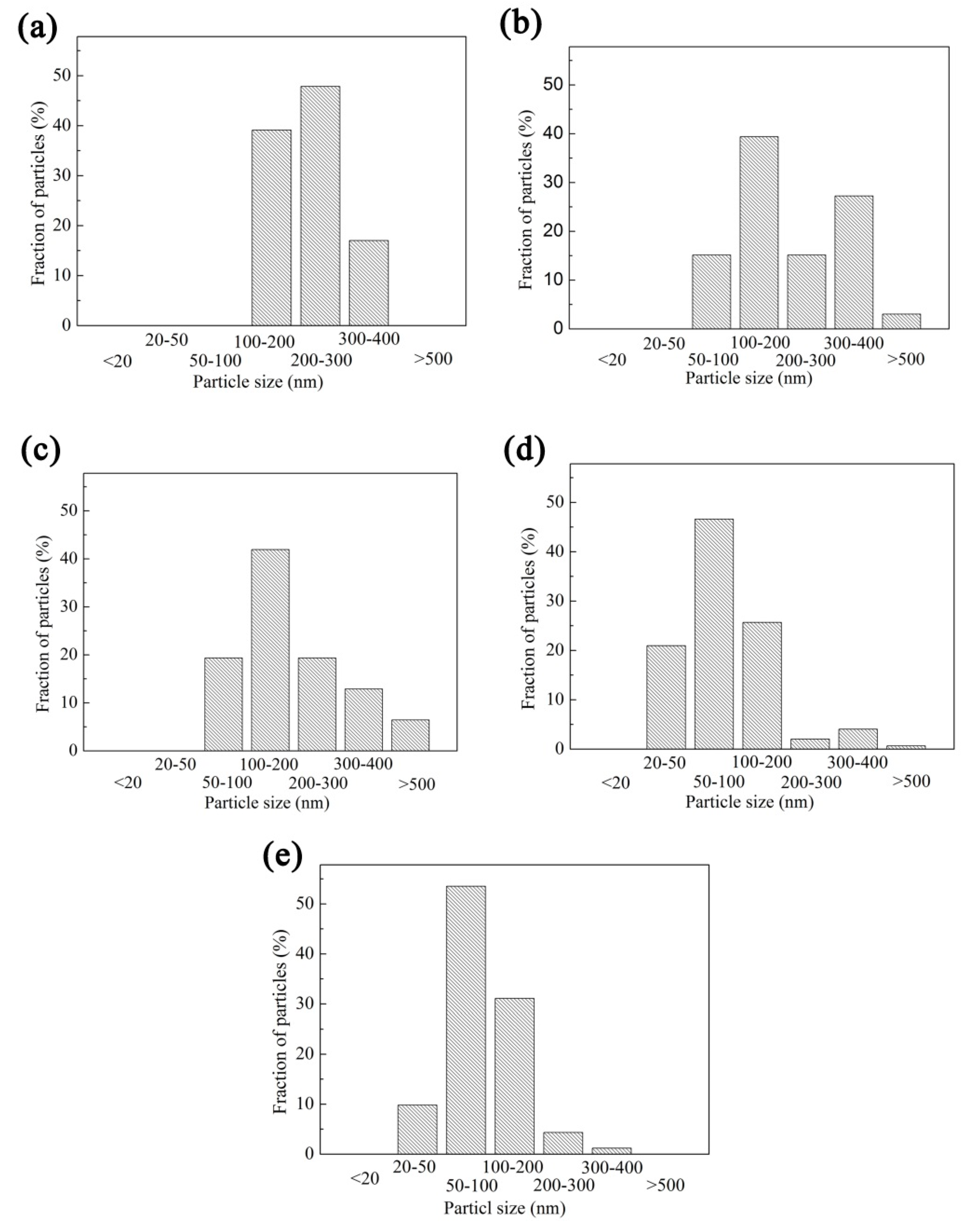Influence of Coiling Temperature on Microstructure, Precipitation Behaviors and Mechanical Properties of a Low Carbon Ti Micro-Alloyed Steel
Abstract
:1. Introduction
2. Experimental Procedure
3. Results and Discussion
3.1. Optical Metallography
3.2. Vickers Hardness
3.3. Precipitation Behavior
3.4. Rolling Experiment
4. Conclusions
Author Contributions
Funding
Conflicts of Interest
References
- Yoshimasa, F.; Tsuyoshi, S. Development of high strength hot-rolled sheet steel consisting of ferrite and nanometer-sized carbides. ISIJ Int. 2004, 44, 1945–1951. [Google Scholar]
- Kim, Y.W.; Kim, J.H.; Hong, S.G.; Lee, C.S. Effects of rolling temperature on the microstructure and mechanical properties of Ti–Mo microalloyed hot-rolled high strength steel. Mater. Sci. Eng. A 2014, 605, 244–252. [Google Scholar] [CrossRef]
- Liu, D.S.; Cheng, B.G.; Chen, Y.Y. Strengthening and toughening of a heavy plate steel for shipbuilding with yield strength of approximately 690 MPa. Metall. Mater. Trans. A 2013, 44, 440–455. [Google Scholar] [CrossRef]
- Yong, Q.L.; Ma, M.T.; Wu, B.R. Microalloy Steel-the Physical and Mechanical Metallurgy; Machinery Industry Press: Beijing, China, 2006. [Google Scholar]
- Senuma, T. Present status of future prospect s f or precipitation research in the steel industry. ISIJ Int. 2002, 4, 1–12. [Google Scholar] [CrossRef]
- Misra, R.D.K.; Tennetis, K.K.; Weatherly, G.C.; Tither, G. Microstructure and texture of hot-rolled Cb-Ti and V-Cb microalloyed steels with differences in formability and toughness. Metall. Mater. Trans. A 2001, 34, 2041–2051. [Google Scholar] [CrossRef]
- Craven, A.J.; He, K.; Garvie, L.A.J.; Baker, T.N. Complex heterogeneous precipitation in titanium-niobium microalloyed Al-killed HSLA steels-(Ti, Nb)(C, N)particles. Acta Mater. 2000, 48, 3857–3868. [Google Scholar] [CrossRef]
- Han, Y.; Shi, J.; Xu, L.; Cao, W.Q.; Dong, H. TiC precipitation induced effect on microstructure and mechanical properties in low carbon medium manganese steel. Mater. Sci. Eng. A 2011, 530, 643–651. [Google Scholar] [CrossRef]
- Kazuhiro, S.; Yoshimasa, F.; Shinjiro, K. Hot rolled high strength steels for suspension and chassis parts “NANOHITEN” and “BHT® steel”. JFE Technical. Rep. 2007, 10, 19–25. [Google Scholar]
- Sun, C.F.; Cai, Q.W.; Wu, H.B.; Mao, H.Y.; Chen, H.Z. Effect of controlled rolling processing on nanometer-sized carbonitride of Ti-Mo ferrite matrix microalloyed steel. Acta Metall. Sin. 2012, 48, 1415–1421. [Google Scholar] [CrossRef]
- Wang, X.N.; Di, H.S.; Du, L.X. Effects of deformation and cooling rate on nano-scale precipitation in hot-rolled ultra-high strength steel. Acta Metall. Sin. 2012, 48, 621–628. [Google Scholar] [CrossRef]
- Xu, Y.; Zhang, W.N.; Sun, M.X.; Yi, H.L.; Liu, Z.Y. The blocking effects of interphase precipitationon dislocations’ movement in Ti-bearing micro-alloyed steels. Mater. Lett. 2015, 139, 177–181. [Google Scholar] [CrossRef]
- Xu, L.X.; Wu, H.B.; Tang, Q.B. Effects of Coiling Temperature on microstructure and precipitation behavior in Nb–Ti microalloyed steels. ISIJ Int. 2018, 58, 1086–1093. [Google Scholar] [CrossRef] [Green Version]
- Xu, Y.; Sun, M.X.; Zhou, Y.L.; Liu, Z.Y.; Wang, G.D. Effect of Mo on nano-precipitation behavior and microscopic mechanical characteristics of ferrite. Steel Res. Int. 2015, 86, 1056–1062. [Google Scholar] [CrossRef]
- Natarajan, V.V.; Challa, V.S.A.; Misra, R.D.K. The determining impact of coiling temperature on the microstructure and mechanical properties of a Titanium-Niobium ultrahigh strength microalloyed steel: Competing effects of precipitation and bainite. Mater. Sci. Eng. A 2016, 665, 1–9. [Google Scholar] [CrossRef]
- Xu, Y.; Sun, M.X.; Yi, H.L.; Liu, Z.Y. Precipitation behavior of (Nb,Ti)C in coiling process and its effect on micro-mechanical characteristics of ferrite. Acta Metal. Sin. 2015, 51, 31–39. [Google Scholar]
- Gan, X.L.; Yuan, Q.; Zhao, G.; Ma, H.W.; Liang, W.; Xue, Z.L.; Qiao, W.W.; Xu, G. Quantitative analysis of microstructures and strength of Nb-Ti microalloyed steel with different Ti additions. Metall. Mater. Trans. A 2020, 51, 2084–2096. [Google Scholar] [CrossRef]
- Toshio, M.; Hitoshi, H.; Goro, M.; Tadashi, F. Effects of ferrite growth rate on interphase boundary precipitation in V microalloyed steels. ISIJ Int. 2012, 52, 616–625. [Google Scholar]
- Jose, C.M.; Guillermo, E.; Estela, P.T. Characterization of microalloy precipitates in the austenitic range of high strength low alloy steels. Steel Res. 2002, 73, 340–345. [Google Scholar]
- Yen, H.W.; Chen, P.Y.; Huang, C.Y.; Yang, J.R. Interphase precipitation of nanometer-sized carbides in a titanium-molybdenum-bearing low-carbon steel. Acta Mater. 2011, 59, 6264–6274. [Google Scholar] [CrossRef]







| Heating Temperature °C | Cooling Rate °C/s | Coiling Temperature °C | Yield Strength MPa | Tensile Strength MPa | Elongation % |
|---|---|---|---|---|---|
| 1200 | 20–30 | 630 | 682 ± 2.1 | 742 ± 4.9 | 24.2 ± 1.7 |
© 2020 by the authors. Licensee MDPI, Basel, Switzerland. This article is an open access article distributed under the terms and conditions of the Creative Commons Attribution (CC BY) license (http://creativecommons.org/licenses/by/4.0/).
Share and Cite
Sun, M.; Xu, Y.; Du, W. Influence of Coiling Temperature on Microstructure, Precipitation Behaviors and Mechanical Properties of a Low Carbon Ti Micro-Alloyed Steel. Metals 2020, 10, 1173. https://doi.org/10.3390/met10091173
Sun M, Xu Y, Du W. Influence of Coiling Temperature on Microstructure, Precipitation Behaviors and Mechanical Properties of a Low Carbon Ti Micro-Alloyed Steel. Metals. 2020; 10(9):1173. https://doi.org/10.3390/met10091173
Chicago/Turabian StyleSun, Mingxue, Yang Xu, and Wenbo Du. 2020. "Influence of Coiling Temperature on Microstructure, Precipitation Behaviors and Mechanical Properties of a Low Carbon Ti Micro-Alloyed Steel" Metals 10, no. 9: 1173. https://doi.org/10.3390/met10091173




